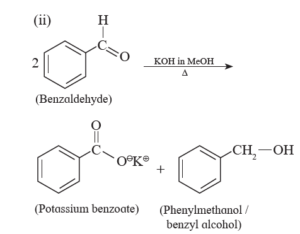12. ALDEHYDES, KETONES AND CARBOXYLIC ACIDS
4. Answer the following
i. Write a note on –
a. Cannizaro reaction
b. Stephen reaction.
- This reaction is given only by aldehydes having no α-hydrogen atom.
- Aldehydes undergo self -oxidation and reduction reaction on heating with concentrated alkali.
- In Cannizzaro reaction, one molecule of an aldehyde is reduced to alcohol and at the same time the second molecule is oxidized to carboxylic acid salt. Thus, the reaction is an example of disproportionation reaction.

12. ALDEHYDES, KETONES AND CARBOXYLIC ACIDS page 281
Question bank with Solution
Text book Solution
NCERT Solutions
NCERT Solutions for Class 12 Maths
NCERT Solutions for Class 12 Physics
NCERT Solutions for Class 12 Chemistry
NCERT Solutions for Class 12 Biology
NCERT Solutions for Class 11 Maths
NCERT Solutions for Class 11 Physics
NCERT Solutions for Class 11 Chemistry
NCERT Solutions for Class 11 Biology
NCERT Solutions for Class 10 Maths
NCERT Solutions for Class 10 Science
Board/University Study Material
Question Paper Solutions
CBSE Previous Year Question Paper With Solution for Class 12 Arts
CBSE Previous Year Question Paper With Solution for Class 12 Commerce
CBSE Previous Year Question Paper With Solution for Class 12 Science
CBSE Previous Year Question Paper With Solution for Class 10
Maharashtra State Board Previous Year Question Paper With Solution for Class 12 Arts
Maharashtra State Board Previous Year Question Paper With Solution for Class 12 Commerce
Maharashtra State Board Previous Year Question Paper With Solution for Class 12 Science
Maharashtra State Board Previous Year Questio n Paper With Solution for Class 10
CISCE ICSE / ISC Board Previous Year Question Paper With Solution for Class 12 Arts
CISCE ICSE / ISC Board Previous Year Question Paper With Solution for Class 12 Commerce
CISCE ICSE / ISC Board Previous Year Question Paper With Solution for Class 12 Science
CISCE ICSE / ISC Board Previous Year Question Paper With Solution for Class 10
